The humble carbon fiber record brush is an essential accessory for any turntable. If you don’t already own one, you should change that pretty quickly and start incorporating one into your daily playback routine.
It’s good practice to use one before and after each play, as this will help to prevent dust and dirt building up into a bigger problem further down the line.
Regular use of a carbon brush will reduce the amount of wet cleaning required to remove stubborn dirt and dust.
How to Use a Carbon Fiber Record Brush
The correct use of an anti-static record brush is often misunderstood. Here’s a simple but effective method that works:
Step 1: With the record spinning, gently hold the brush over the record so the carbon fibers just tickle the surface (if they’re squashing flat onto the record surface they won’t work properly). You want to allow the fiber tips to penetrate the grooves.
Step 2: While holding the brush gently in place, allow the record to spin on the platter a few times.
Step 3: Most of the dust will gather at the front fibers. Now, gently scoop up the front fibers allowing the rear set of fibers to catch anything missed by the front. Now lift the brush. Repeat this process if necessary.
Step 4: Inbetween each clean, you can use the handle to clear any collected dust by rocking the fibers back and forth through the handle. This way, you don’t have to touch the brush with your greasy fingers.
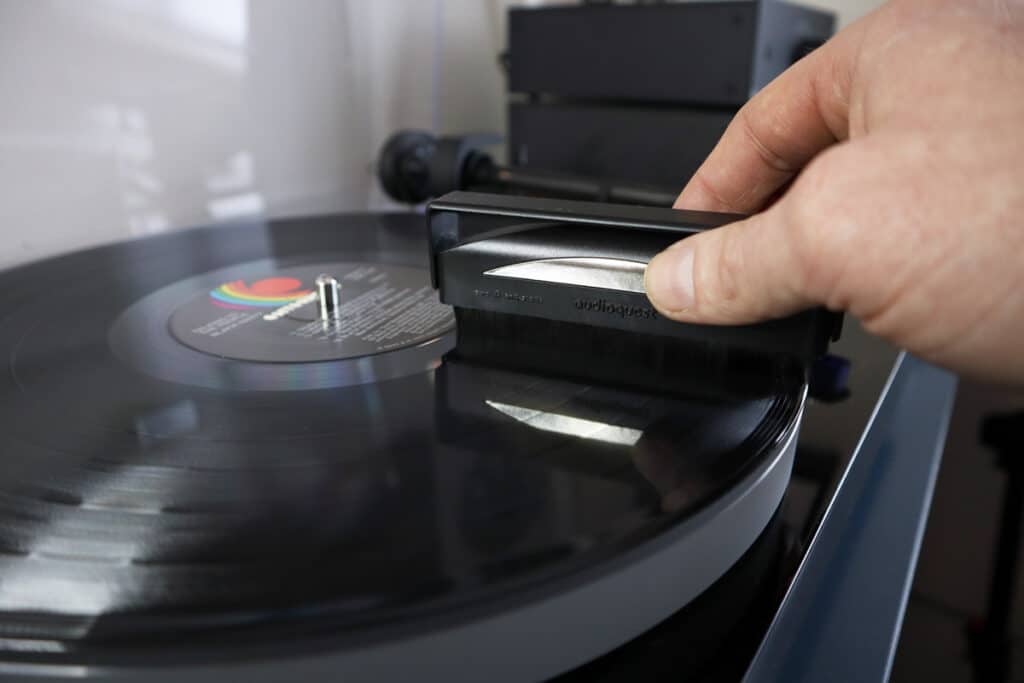
Debate About The Correct Method
There is much debate about the correct way to use a carbon fiber brush. And most of this debate centers around how to remove the brush.
For example, some folks will recommend slowly moving toward the center allowing the brush to make contact with the metal spindle before lifting. The theory is that this method helps to discharge static.
Another example is where users recommend slowly pulling the brush in the opposite direction – toward the edge of the record.
The main issue I can see with both of these methods is that they both involve dragging the brush across the record surface. There is always a risk you could drag a particle across the record, causing damage.
Audioquest recommends the method I’ve laid out in this article, as per the included instructions, pictured below:
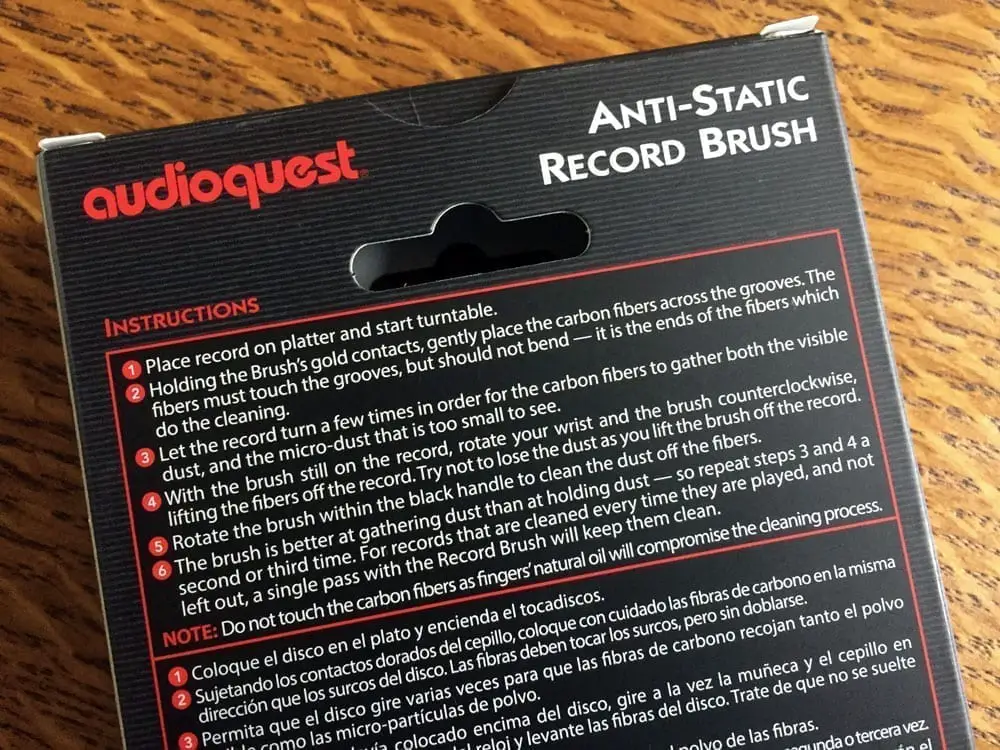
What’s the Best Anti Static Record Brush?
The Audio Quest carbon fiber brush is the classic. There are many others like it, but this is the one that’s been a mainstay of the industry for decades. It features 12,000 highly conductive carbon fibers in two rows that gently reach into the groove, helping to pull out dust and dirt when used correctly.
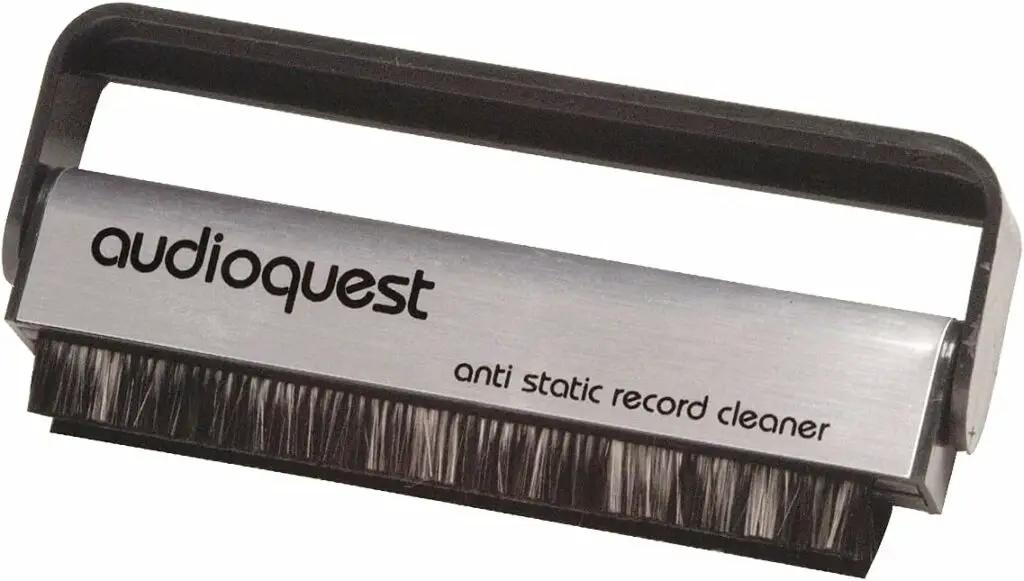
Improving on a Classic
A classic the standard Audio Quest brush might be, but could it be improved? Perhaps, and that’s just what Audio Quest say they’ve done by introducing a new model.
The new brush is said to improve the conductivity of static electricity and facilitate better cleaning of micro-dirt particles through the use of smaller fibers in a greater quantity (624,000 carbon fibers to be more precise).
The improved connectivity comes through the brush’s internal parts to the conductive gold contacts where your fingers should be, allowing better discharge of static electricity through your body as the ground. We recommend upgrading to the new brush if you can.
Purchase the new
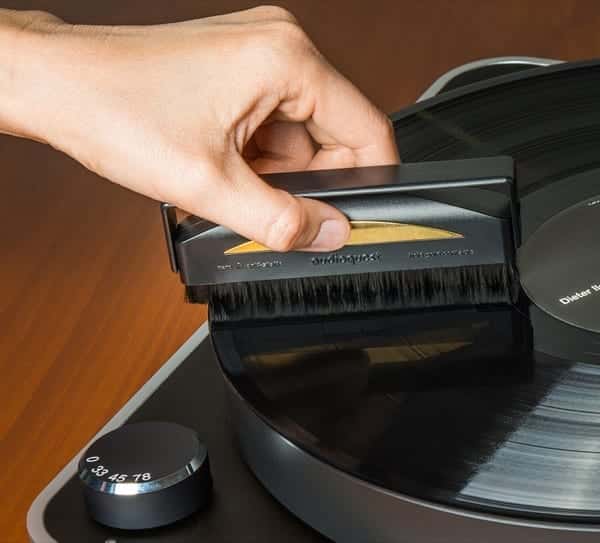
Do Carbon Fiber Record Brushes Kill Static?
Carbon fiber record brushes do a great job of removing loose dust and debris from the record surface, preventing excessive build-up. However, if a record is charged with static electricity, an “anti-static” carbon fiber record brush alone will not neutralize the record surface (in my experience).
If your records are charged with static, the best way to neutralize the record surface is to use an anti-static gun, such as the MiltyZero Stat. Alternatively, you can wet clean the record and this will remove the static charge that’s attracting more unwanted airborne dust!
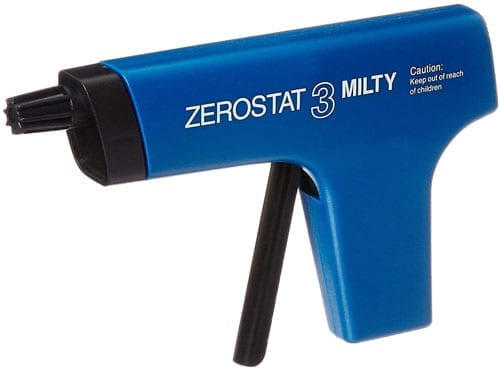
The Bottom Line
Dry cleaning records regularly before and after playback with help remove dust and dirt before it becomes embedded in the grooves. However, this process will not remove fingerprints, grease or other more stubborn dirt. If the record has become very dirty, you will need to consider some form of wet cleaning. For more information, read our article on how to clean vinyl records.

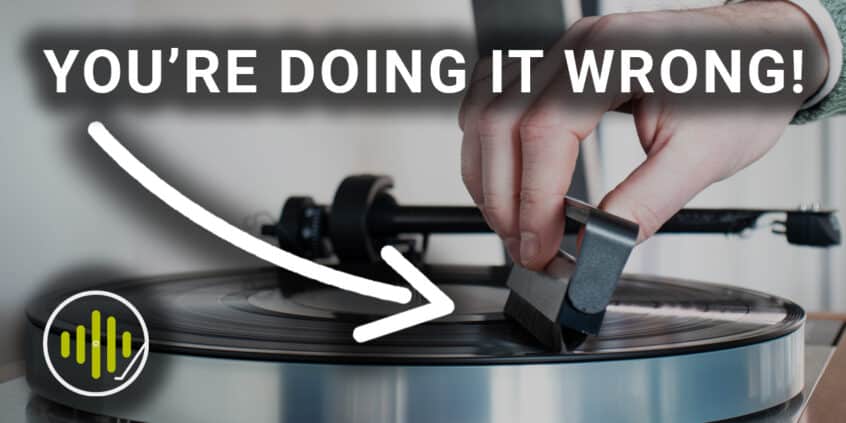


Your method is very useful but not the correct way to remove dirt , or static electricity. If your going to neutralize the static first, then apply your brush for in between cleaning. I have purchased a separate turntable mat for my cleaning process. I then lay the record on top and apply cleaning solution,a few drops and spread it with a cleaning pad. Rotating the brush around the surface. Repeat with another dry brush to facilitate a smooth transition off the vinyl. Inspect your vinyl by tilting it in the light to ensure there are no dull spots. Flip or and repeat. I can say that I can see my reflection I’ve done a great job. To be fanatical about my process it really pays off in listening. Just like to say my very first album is just as good sounding as it did 50 years ago.
Thanks for your comment. Oh, for sure, a dry record brush will not replace wet cleaning, only control dust build-up over time.
Naturally, wet cleaning will remove the static electricity as you suggest; lots of content on the site about this.
I’m a huge advocate of GrooveWasher record cleaning fluid and the Pro-Ject VC-E machine. Hummingguru ultrasonic is useful in many cases also.
Happy spinning! And thanks for sharing your routine with us.
A carbon fibre brush whether its from audioquest or a generic brand intoduces static because of friction. How do I know this, by testing using using a test instrument for the presence static electricity. So which ever method you use, de stat with a milty antistatic gun after. Remember to de stat both sides of the record and please do not follow de magetizing instructions as I see posted on you tube. We are removing static not magnetism from a record the two methods are quite different
A good video but what you said could have been done in 1/2 the time. Regardless it was a good video. I just wonder why you say to clean it with the CF brush without mentioning first to clean the record with a record cleaning solution? I understand if the record isn’t dirty but you said a dirty record just use the CF brush.
I think you should use a CF brush before using a wet method; if there is a lot of dust and such, wetting it will turn it into “mud” and may make it harder to remove. I get the loose dirt with the CF brush; then, if the situation calls for it, I go after it with a wet clean using different solutions and brushes.
Yes, I go by this as well, MVP. Remove as much of the loose stuff first before any wet cleaning. Happy spinning!
First off, let me just say that I think the Audioquest record brush with the gold contacts is absolutely the bomb when used correctly. Completely effective for before and after playing. And no static cling. I follow their directions implicitly this way: I place the brush on the record WITHOUT PRESSING. It’s very important to let only the weight of the brush touch the surface of the record as evenly as possible. I start at the 9 o’clock position perpendicular to the spindle, let the record rotate three or four times, and then gradually swing the brush counterclockwise to the edge of the record before lifting off. Works every time.
Thanks Paul. Yea, it works great for me too and works better with the gold contacts.
I know this is old but im so confused- how can you rotate counterclockwise if the record is turning clockwise? Do you suggest changing the direction of the brush?
He means the brush: so simply moving it in the opposite way to how the record spins. Hope that helps
[…] correct method for using a carbon fiber record brush is a hotly debated topic, but here’s how we do […]
[…] To learn more, read our guide on ‘how to correctly use a carbon fiber record brush’. […]
[…] water. If you want to know more about how to clean your records the correct way you can read this great article. Or watch the video […]
[…] Clearly, a carbon fiber record brush is an essential tool in any vinyl collectors arsenal. You can read more about how to use a carbon fiber brush to clean records in our previous article. […]
[…] – Clean any initial surface level dust from the record surface using a carbon fiber record brush. (This is good advice, as you want to remove as much of the loose stuff as possible first before […]
[…] of record cleaning, realistically, we can file this one under the topic of record maintenance. A carbon fiber record brush is a tool you should use daily on your records (ideally before and after each spin of a record side). It will help to lift loose […]